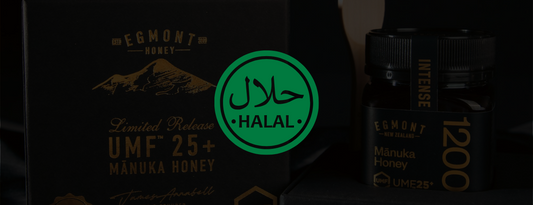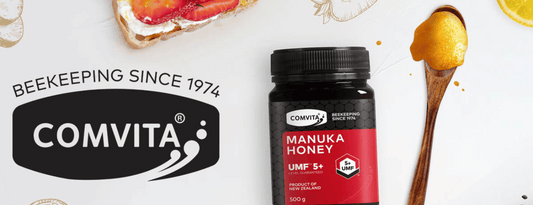Starting with a single beehive gifted for Christmas, Egmont Honey has grown into one of New Zealand's leading Manuka honey producers, with over 4,000 hives throughout the South Taranaki region. This humble beginning came about when founder James Annabell gifted his father, conservationist Toby Annabell, a beehive, a fitting gift that soon sparked a passion for authentic Mānuka honey and ethical beekeeping.
What began as one hive quickly multiplied into hundreds, and then thousands, nestled in the Annabell’s South Taranaki farm. Today, this family business has become a beekeeping powerhouse, with rich honey flowing from their hives to their purpose-built factory in New Plymouth, Taranaki. Now, Egmont Honey shares its unique Manuka honey across over 25 countries.
Recently, the team at Manuka Hut caught up with James Annabell to ask about Egmont Honey’s journey and his vision for producing the purest Manuka honey in New Zealand. His answers offer a look into the heart of Egmont Honey’s operations, their commitment to quality and sustainability, and their deep respect for New Zealand’s native bush and bee populations.

Interview with founder James Annabell
What Makes Egmont’s Environment Ideal for Producing High-Quality Manuka Honey?
"There is a lot of steep, rugged hill country in this region which is unsuitable for traditional pastoral farming, so it has been left to regenerate into native bush.
The Mānuka bush in particular thrives in these remote, isolated conditions which allows bees to produce such rich and potent Mānuka Honey.
Our hives are left in these isolated sites with no disturbances. There’s nothing to hide, nothing but nature."
Could you walk us through the process from hive to jar? How do you ensure the honey retains its purity and potency?
"We go to great lengths to harvest our Mānuka Honey.
The powerful white flower of the Mānuka tree blooms for only six weeks of the warm New Zealand summer, and flourishes only in the wildest, remote places.
Our bees are only able to forage exclusively on the rich nectar after being transported by vehicle and then helicopter to these isolated sites.
In this rare window to make magic, our bees create this rare honey packed with methylglyoxal - commonly referred to as MGO - which is scientifically proven to promote antibacterial activity. It’s for this reason Mānuka Honey is revered for its wound healing capabilities, and supports immune function and digestion.
Our Mānuka Honey is carefully harvested by our beekeepers before making the journey to our own factory in Taranaki, on the West Coast of New Zealand’s North Island.
At our factory, the honey passes through coarse filters to ensure safe consumption, before being cold processed and bottled. Each batch is independently tested by Hills Laboratory to ensure its authenticity and potency."
What certifications or testing does Egmont Honey undergo to guarantee high standards?
"Egmont Honey holds BRC accreditation which is a worldwide recognised Food Safety Standard. We send a sample from every Mānuka Honey batch to an independent Laboratory to test for MGO, NPA (UMF) and the MPI Manuka Tests to prove that it is either a Multifloral Manuka (MGO certified) or a Monofloral Manuka (UMF certified).
We are a certified brand with the UMF Association so you can rest assured that the Mānuka Honey you purchase from us is genuine and authentic. We are also audited regularly to maintain both Halal and Kosher certifications."

What steps do you take to ensure your honey is free from contaminants like pesticides, antibiotics, or glyphosate residue?
"We proudly hold a Glyphosate residue free certificate and are audited on this regularly. New Zealand beekeepers are also not permitted to use antibiotics in the beehives by law, so you will never find antibiotics in our Mānuka Honey."
Sustainability is important to many consumers today. How does Egmont Honey incorporate sustainability and ethical practices into your beekeeping and production processes?
-
100% Recycled Plastic
"Our products are packed into 100% recycled plastic rPET jars. Did you know it requires 79% fewer greenhouse emissions and less energy to create recycled PET jars than new plastic jars?"
-
Hive to Home
"We own the farm, the hives and the factory, meaning a smaller supply chain and lower greenhouse gas emissions!"
-
Regenerative Farming for the Future
"We're returning farmland to its former state by planting Mānuka trees alongside other New Zealand natives. We're also working with the Taranaki Kiwi Trust to trap introduced predators on our South Taranaki farm. This means we will eventually be able to introduce Kiwi into the native forest that makes up the the majority of the farm!"
How does Egmont work to protect and nurture bee populations while maintaining the high production of Manuka honey?
-
No Commercial Pollination
"Some apiaries move their bees to commercial orchards during the winter, but our girls work hard enough making honey during the summer. We leave them to rest during the 'off season' to reduce any extra stress."
-
Increasing Bee Populations
Bees are integral to the ecosystem. Without pollination, we would have no food and therefore no life as we know it. Our beekeepers carefully and ethically foster queen bee numbers through disease and swarm management, so that the population can thrive.
majority of the farm!"
What differentiates Egmont Honey from other Manuka honey producers in the market?
"We have a unique hive to home operation – we own the land, the hives and the factory, which gives us a unique advantage in making sure every step of the process is stamped with quality. We’re family founded and family run, and employ over 50 locals between our factory and beekeeping team."
Are there any innovative ways consumers can use Egmont Manuka honey beyond traditional uses?
"The MGO in Mānuka Honey has been scientifically proven to promote antibacterial activity and is regularly used by hospitals for wound care. This can apply to your skincare regime too – simply dab onto dry skin, acne, small grazes or cuts, and watch the Mānuka Honey work its magic!"
What would you say to a customer who’s unsure about introducing Manuka honey into their daily routine?
"We understand that Mānuka Honey is considerably more expensive than your typical bush honey off the shelf. If you’re new to Mānuka Honey, our recommendation is to start with a low grade MGO 50+ as an affordable everyday honey. Once you start feeling the benefits you can start moving up to higher grade Mānuka Honey. Remember, you only require one teaspoon of the high grade Mānuka Honey each day to reap the benefits, so it’s worth the investment for a health supplement that will last you a long time."
James Annabell - Founder and CEO of Egmont Honey
James has been in the honey industry for some time, and fell into his first role while based in Hong Kong playing professional rugby. During his time abroad he developed the Asian market for two of New Zealand's largest honey companies.
“After building up a significant number of bee hives with Toby, I decided to leave the more corporate companies to concentrate 100% of my time on developing the Egmont Honey brand and working with our private label customers.”
James now oversees a large team based in Taranaki, and continues to drive growth and innovation with just as much passion as when the business was first formed.
Manuka Hut is an official reseller of Egmont Honey
As an official Egmont Honey reseller, Manuka Hut brings you exclusive deals on Egmont’s premium Manuka honey. Don’t miss out on our special offers to experience the unique benefits of authentic New Zealand Manuka honey!





